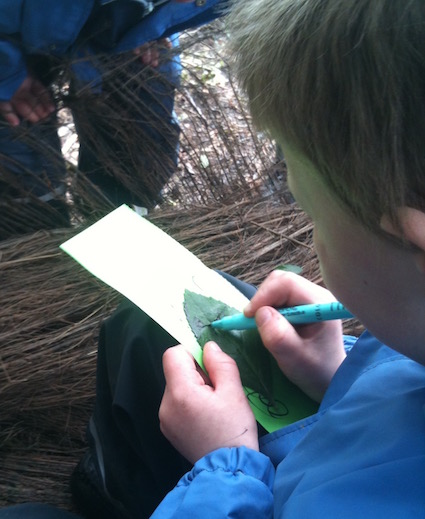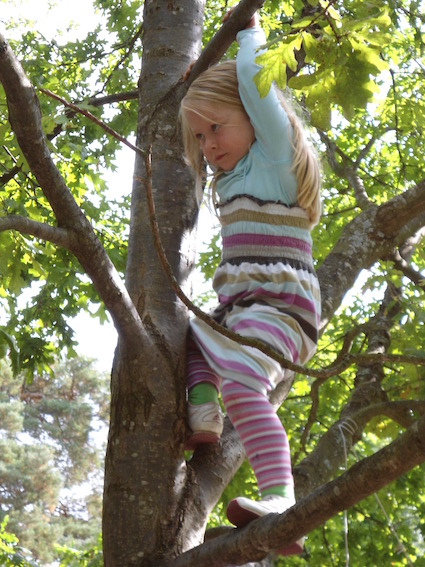
Letter formation is an element of learning to write that works surprisingly well outside. A child’s ability to form letters is strongly linked to their overall development in combination with an interest in and desire to write.
If we introduce formal writing when children are too young or not developmentally ready then we run the risk of creating unnecessary handwriting difficulties. Sian Eckersley – a paediatric occupational therapist has brief commentary about this and the need to integrate of visual, motor, sensory and perceptual systems.
Focus on the process not the end product
Initially it helps to focus on the process of forming letters rather than the end product such as a beautifully formed letter. This means that focusing on the wider skills required to form letters helps along with making letter recognition and awareness meaningful and fun. The act of handwriting with a pencil on paper can come at the end of many other experiences which naturally include those which happen outside.
Take a 3D approach
The advantage of outdoor environments is the sheer range of possibilities:
- Sticks, fingers and other objects can be used to write on soft surfaces such as sand, snow and mud. So you are writing into a surface! There is also the fun of deciding what object to use as your writing tool.
- You can create letters on a surface – see below for ideas about making nature letters.
- Letters are generally created horizontally on a surface but making upright letters can be an interesting challenge for some children – some are more suited than others to this such as capital letters.
- Air writing works well as there is more space for children to move around. See the section below.
Have helpful cards available
In my outdoor literacy “kit” I do have a small whiteboard with all the letters there written in the correct font. This is the sort of resource that I have available in a bag or box outside. In my experience there are always children who really love the challenge of writing over letters or copying them. Inside or out, practitioners need to model correct letter letter formation, appropriate grip and so on as per your school’s handwriting policy.
I also advocate a set of cards which have the formation outlined. These cards can be used by children in different ways:
- They can collect interesting materials such as tiny stones to put over the letter on the card. This can run the risk of being blown away, so creating a clay worm to put on top of the card or using blobs of clay or mud to stick down the found materials can help mitigate this. This is a good hand coordination skill in its own right – the ability to make a worm!
- The cards can be used by children to help remind them what a particular letter looks like. This can help when making a “nature letter” outside from natural materials as the children copy the card.
- The final challenge is for children to be able to form a nature letter from memory.
- If a child wants to take a photo of their work, this can be a lovely way of capturing their efforts.
Make letter formation appealing
With letter formation, the act needs to appeal to children. Thus the letters in a child’s name have special significance and meaning. Another thing to consider is developing reasons to create letters. For example:
- A special place can be marked by “x” to mark the spot.
- “b” has to be the biggest letter possible.
- “r” is a red letter day – so aside from making the letter from red colours, having discussions about what would be a really exciting and special thing to do can be fun. Likewise if there is a special occasion happening then make it a red letter day.
Several years ago, I worked with Cosy to produce a poster to this effect. If you are lucky you may still find a free paper one lurking around as they were distributed with one of their catalogues back in 2013.
Browse this blog for other letter formation ideas
I’ve blogged previously about letters and you can enjoy browsing:
- Sticky Letters – okay for individual children but please don’t waste your time creating whole class letters this way. This particular blog post was about a small class of children with additional support needs.
- Letters from Sticks – very quick and great for spontaneous moments particularly when children notice that a stick has grown in the form of a letter
- Introducing Letters – this is all about using materials found in any outdoor space to form a letter. It’s a creative approach.
- Sammy the 1-metre Rope Snake – whilst this focuses on forming digits, the same process applies to letters. Rope is naturally curvy so great for creating some, but not all, letters.
Air writing outside
This is a lot of fun – encourage children to think of different resources that could add interest and value:
- Pool noodles
- Wands – sticks
- Ribbons on sticks or on bands on wrists
- Hoses that whistle when you swing them
- Tennis ball in an old stocking – swing with hands
- Scarves and lengths of different quick dry materials
- A light saber app can also be downloaded which enables a person to use their phone that emits the sounds of different light sabers when moved about. Stick it in a mitten to avoid it accidentally flying out of a hand.
Remember that using both hands simultaneously can also be of value. Many activities outwith letter formation rely on dexterity of both: playing instruments, many sports activities, etc.
Don’t forget about climbing trees!
Whilst letter formation activities are necessary for children to develop the know-how, this should not be at the expense of wider outdoor experiences that develop the necessary physical, emotional and cognitive skills associated with beginning handwriting. For example if you consider the skills involved in climbing a tree or bouldering these dovetail remarkably well with many needed for the ability to form letters and begin the process of handwriting including:
- Wrist, hand and finger movements including palm, finger and tripod (pincer) grips.
- Hand-eye co-ordination.
- Visual perception – essential for working out which branches will hold one’s weight and whether there’s space between the branches to keep climbing up or down which is also about depth perception.
- Fine motor and coordination skills such as manipulating one’s body, being able to cross the midline, developing muscle tone and strength.
- Large physical movements of the arms and upper body.
- Cognition – ability to remember the pathway up and down through a tree, problem solving, critical thinking and reasoning.
- Sensory processing including: balance and proprioception, developing good posture, and so on…




















